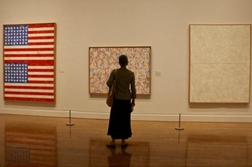
Penn’s Positive Psychology Center has been analyzing a wide swath of psychological research associated with arts and culture, showing museums – in particular art museums – are good at reducing anxiety and depression.
“We’re seeing that going to an art museum is really effective at reducing your stress,” said postdoctoral fellow Katherine Cotter, who recently published her results in The Journal of Positive Psychology. “If we think about the stress hormone cortisol, there’s been a few studies examining if you just go for half an hour to an art museum and measure people’s cortisol levels before they go in, after half an hour it shows the kind of recovery time [normally] equivalent to a few hours.”
Cotter reviewed about 100 published reports from various disciplines related to arts and psychology to find research consensus that attending art museums – as opposed to experiencing art in the street, in a classroom, or online – can have mental health benefits.
“When we enter a museum, we’re entering it with an intention. We’re entering this particular space that has unique art, architecture, and has unique things that we’re going to be seeing whether it’s an art museum or another form of museum or cultural institution,” she said. “We engage different mindsets and different cognitive processes. Once we get into the meat and potatoes of the museum visit, we see ourselves more concerned communally, thinking about how things are interrelated in the world more broadly.”
Positive Psychology is a relatively young field of science, largely spearheaded at Penn by Dr. Martin Seligman, that focuses on accentuating the positive over reducing the negative. Cotter was brought in to work on a particular initiative, Art Museums for Well-Being, but was temporarily thwarted by the widespread museum shutdowns caused by the pandemic.
Instead, she plowed into the existing research to analyze what was already known. Cotter found that research tended to fall into particular categories: stress and anxiety reduction, alleviating pain, measuring emotional well-being, and – what she found most interesting – loneliness.
“It wasn’t just, ‘I look at this artwork and it makes me happy,’ it’s thinking about broader things that facilitate other well-being and flourishing outcomes,” she said. “We know that loneliness and social isolation is a precedent to a host of negative health consequences and outcomes.”
Cotter hopes to use the research analysis to lay a foundation for further work. She said much of the existing research on the benefits of engaging with culture tends to focus on repairing damage to a person’s mental health, i.e. fixing a negative, whereas more work could be done to investigate how arts and culture can cause people to flourish.

 RSS Feed
RSS Feed